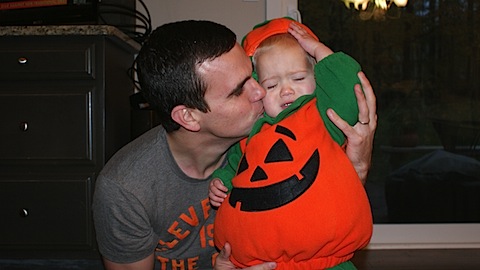Happy Halloween!
We actually decided against both of these costumes. I wonder why? 🙂


So I’ll show you the costume we are going with later today! Hopefully we won’t have a similar situation to the one above. 🙂
Here are a few tips from the California Poison Control Center!
1. Many parents purchase glow-in-the-dark jewelry and glow sticks to keep their children visible while trick-or-treating in the dark. Children may break open these glow sticks and get the liquid on their hands and in their mouths. The liquid can be mildly irritating to the skin or eyes but is not likely to cause harm if a small amount is ingested.
2. Tell children not to eat treats until they return home and all items have been inspected by an adult.
3. Limit the amount of candy ingested at one time. Too much candy can cause stomach discomfort, and sugars and other sweeteners can act as laxatives when consumed in large amounts.
4. If your child brings home a brand of candy that you are unfamiliar with, throw it away. Some imported candies have high levels of lead that can be harmful.
5. Candy that is unwrapped should be discarded immediately.
6. Fruit treats should be washed and cut open before being eaten.
7. Homemade treats should be discarded unless you know and trust the individuals who prepared them.
8. Small pieces of candy are potential choking hazards for small children.
9. Torn, loose, or punctured wrapping may be a sign of tampering. If you suspect tampering, this should be reported to local police.
10. Commercially produced candy may sometimes have color variation, lumps, or powdered sugar residue – all normal effects of the manufacturing and shipping process. To see photos of candy with these normal effects, go to http://www.candyusa.com/
A little info:
As part of its growing mHealth offerings, CPCS recently introduced a free iPhone application, Choose Your Poison, a game now available at the Apple app store in English http://bit.ly/gg9vfG. A Spanish version is also available but the user’s phone must be set up for Spanish. An android version just became available in English and Spanish as well. Both were built in conjunction with University of California, San Francisco School of Medicine’s mHealth team. The Choose Your Poison game is also available online at www.pillsvscandy.com. CPCS kicked off an SMS program with weekly poison tips sent to cell phones by texting TIPS to 69866. Messages are also available in Spanish by texting PUNTOS to 69866.
Be safe!



HAPPY HALLOWEEN!!!